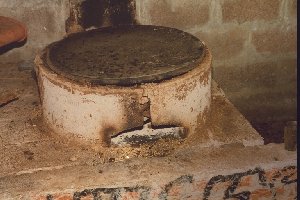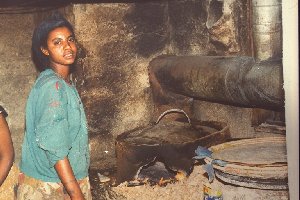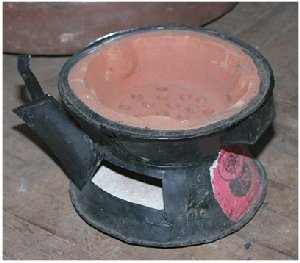



Mirte, Ethiopia
Mike Bess, Energy for Sustainable Development, UK
 |
 |
| Mirte after 1 year | Traditional Baker |
 |
 |
| Baker with Three Mirtes | Lakech |
We began working in Ethiopia with the Ministry of Mines and Energy under the World Bank- funded Biomass Fuels Supply and Marketing Review in 1988 as part of a major national and international effort to address Ethiopia's deteriorating environment. We (Energy for Sustainable Development, a private UK firm) worked with a dedicated team of Ethiopian counterparts developed the first national profile of commercial wood and other biomass production, marketing, distribution and sales in Ethiopia. This formed the basis for all subsequent household energy work ESD has carried out in Ethiopia since 1988.
This study showed that Ethiopia had a complex and highly commercial biomass fuel sector. It showed the most important areas for improving household cooking efficiency in Ethiopia. The study further provided the basis for interventions to improve household energy use through commercial channels, rather than through traditional governmental controls. ESD's study also provided the basis for developing a commercially-oriented approach that would involve small- scale, informal sector artisans in the production of improved stoves with a wide appeal to consumers in many parts of the country.
ESD first began work on an improved charcoal stove with a core Ethiopian government team in late-1989. Working with this dedicated team of experts, ESD followed a process that has led to the sales of several hundred thousand stoves through the private informal sector, with no government subsidies, and with an eye towards making these sales self- sustaining in the shortest time possible. Consumer needs were first assessed. Then., producers' capabilities were determined. Improved designs on old stoves were made and tested. Laboratory and household tests were carried out. Pilot production took place, and market trials were undertaken when results proved possible.
This led to the development of the "Lakech" ("excellent", "good") improved charcoal stove in 1991. Commercial production began in earnest on the Lakech in early-1992 in Addis Ababa. To date, over 300,000 of these improved stoves, which save over 25% charcoal relative to the traditional stove, have been sold in Ethiopia. Monthly sales now exceed 10,000 in Addis Ababa alone. This has resulted in the saving of hundreds of hectares of ecologically and economically important dryland forest in Ethiopia. Each Lakech stove saves an average of 75 kg of charcoal per household per year. This led to savings of over 20,000 tonnes of charcoal in 1996, worth over £4 million alone. More important, the forest savings from the use of the Lakech was equal to the equivalent of over 2,000 hectares of important dryland forest in Ethiopia.
However, from the earliest days of ESD's involvement with household energy in Ethiopia, ESD's international and local team realised that the single most significant household energy demand side intervention was not in household charcoal use, important as this has been. Rather, the most crucial area for energy savings in Ethiopia is in household bread, or "injera" baking.
Injera is the staple flatbread food for most Ethiopian and Eritrean households. It accounts for over 50% of all energy consumption in Ethiopia, and over 90% of all household energy consumption. Biomass remains the most important energy source for the vast majority of Ethiopia's urban and rural households.
ESD and its Ethiopian counterparts began work on designing an improved biomass injera stove in 1990. Numerous attempts were thwarted by the unique requirements of injera baking. Injera requires a quick, fast heat, evenly distributed over a 60 cm round traditional ceramic plate. Traditional baking is carried out on a three stone fire, with fuel fed in from all sides. While this produces the hot, fast flames required for good injera, it is highly energy inefficient, unsafe and unhealthy. Efficiency of fuel conversion is less than 7% (ie, 93% of the fuel is wasted). Smoke is produced in large quantities. Heat from baking burns many cooks. The whole activity is one of the most unpleasant, and dangerous, household tasks.
ESD worked with John Parry Workshops of the UK to develop a modular, prefabricated stove from cement and local construction materials that could be produced relatively easily, in large quantities, by a range of different scale producers, at inexpensive prices. While this proved difficult, the team was finally able to meet this challenge in early- 1994 with what was soon to be called the "Mirte" ("best") improved biomass injera stove.
The Mirte reduced fuel consumption by nearly 50% in the laboratory. Household trials not only showed similar results, but also demonstrated that cooks found the stove appealing on a number of counts. Reducing the smoke was, and is, of major importance. Protecting the cook from flames was, and is, also very important. Finally, reducing energy expenditures by half makes the Mirte one of the most popular items to appear on the Ethiopian household market since the Lakech improved charcoal stove.
The British Overseas Development Administration (ODA) came in with a two year programme of support for the Mirte in early-1995. This enabled ESD and its Ethiopian team to move the Mirte to its commercial phase. The Mirte can be produced on a large-scale, by mechanical means. It can also be produced on a small scale by hand. It can be produced from virtually any building materials. These factors have combined to make this stove very popular with small- scale artisans in many parts of Ethiopia.
Production and marketing strategies have been very successful with this technology. Sales averaged 50 per month in late-1995. By late-1996, they topped 1,000 per month. Today (June 1997), sales are over 2,000 per month. Nearly 100 people are currently involved full-time in the commercial production and sales of the Mirte in eight different urban areas. Four small revolving credit schemes are in operation, providing credit and finance (maximum £100 per loan) to a dozen small business men and women. Regional and local authorities are providing training and promotion to provide local artisans and sellers with support to accelerate the Mirte's commercialisation. Women producers and sales people are very active in the Mirte. The Mirte is attractive first because it reduces smoke significantly. Second because it is "modern". Third because it protects the cook from fire. Fourth because it saves fire. We have conducted nearly 500 consumer follow on surveys and interviews. These are the results the cooks cite for purchasing the stoves.
The potential market for the Mirte is in the millions, and regional authorities, non-governmental organisations, and small-enterprise support organisations throughout Ethiopia are taking active interest in the stove. One of the important features of the Mirte's success is its popularity with commercial injera bakers. These are housewives who earn almost all their income from baking and selling injera to hotels, small restaurants and other households. Thousands of injera bakers have already purchased the Mirte.
Each Mirte saves approximately 5 kg of wood per injera baking session for the average household. Most housewives bake injera twice a week. Thus, the Mirte saves the average household nearly 260 kg of wood a year, worth over £16. The stove sells for just under £3, thus paying for itself in almost two months. This is a significant savings for the average Ethiopian urban household. However, the Mirte saves commercial injera bakers over 3.5 tonnes of fuelwood per year, a savings of roughly £200 per year. This pays for the stove in days, and makes the sale of injera even more profitable for women bakers.
Beyond the fact that the Mirte saves households and commercial bakers money, and protects them from smoke and flames, it also saves Ethiopia scare forestry resources. With the current number of stoves in use, woodfuel savings of over 15,000 tonnes will be realised in 1997, equivalent to the sustained yield of over 3,000 hectares of forests. However, if sales continue at their current rate, over 25,000 Mirte stoves will be in use by the end of 1997, saving 95 tonnes of wood per day or approximately 35,000 tonnes per year.
ESD is now funding these efforts and the expanded commercialisation of the Mirte with its own resources. We are now at the point where nearly a quarter of all sales are taking place in small urban and rural areas, households tied to the case economy. Our work relies upon a highly trained and dedicated team of Ethiopians who have the freedom to test a variety of production, promotion and commercialisation approaches. This has further permitted the widespread dissemination of the Mirte to a number of areas in Ethiopia.
There are several priority areas for continued assistance to help the Mirte achieve the widespread commercialisation that will make a major difference to save hundreds of thousands of tonnes of wood and thousands of hectares of Ethiopia's forest resource base. The most important next steps which need to be taken include:
development of a viable, commercially acceptable commercial bakers' Mirte, which can be utilised under commercial circumstances (ie, 300-500 injeras baked per day for seven days a week, compared to 30 per session twice a week in the average household); national advertising on television and radio to promote the stove on a large-scale; familiarisation sessions with regional and local authorities, small and medium enterprise support organisations, and other organisations who assist women, small-scale businessmen, and the environment; training of artisans on the commercial production, sale and installation of the Mirte throughout Ethiopia; expanding the number of small revolving funds which provide capital (average loans of less than £50 per recipient, to more areas in Ethiopia; setting up innovative credit schemes (e.g., credit purchase) for large numbers of consumers such as is being tried on a pilot basis by ESD (loans payable over 3-4 month period, at value of £4 per loan); providing on-going monitoring and evaluation of stove quality and production to maintain high standards, and to provide this feedback through public and national channels to improve consumer and producer awareness; dissemination of results nationally and internationally; and, international replication.
The Mirte's success is relevant to other countries in the developing world, and to other technologies. Disseminating these results should be a high priority to show that innovative approaches to household energy conservation can be commercially successful, without massive donor and government support, subsidies and interventions. The Mirte, and the Lakech improved charcoal stove developed by ESD and its Ethiopian colleagues, demonstrate the vibrancy and potential of the small-scale informal sector in the developing world. They show that local technology can be adapted and improved to meet local needs and demands which can, in turn, be met by local producers and specialists. They show that important environmental, health, safety, social equity and income generating targets can be met through a partnership between the informal private sector, local and international experts, governments and donors. ESD and its local Ethiopian counterparts believe that these factors are relevant in many other parts of the world, and hope that the examples provided by these two household energy technology "successes" can be applied successfully elsewhere.
So, there you are with a pretty detailed summary of what we have been doing. Back to the photos. I'll include all the ones of the Mirte again. The first is of a traditional baker . W/t Tsigereda is a traditional injera baker baking on an open fire. One can see the smoke and how exposed the cook is to fire. She must feed wood and branches from all sides. The highly volatile nature of some of the materials, such as eucalyptus branches and leaves, often causes a "flashback" which severely burns an estimated 20% of all women during hte course of their lives.
The second photo a commercial injera baker with a bank of three Mirtes (only one showing, with a poorly rigged chimney). She and her sister were one of the "early adopters" of the Mirte. She purchased three stoves and mounted them in her house with a juryrigged chimney. We have since replaced the chimney array to make it more effient, but this photo was shot to show how popular the stove is, how innovative cooks are, and the robustness of the stove after over one year's baking. The Mirte was designed for ordinary household use, which averages two baking sessions per week, three hours at a time, to bake 30 injeras. Commercial bakers will bake anywhere from 150 to 600 injeras per day, start work at 3 in the morning and work until 9 in the eve. The stove is subjected to enormous stress. Yet, 100% of the 100+ commercial bakers we randomly lcoated for our follow ups are still using their original stoves, some nearly 2 years on!!!!!
The third photo which I did not manage to send last time is a Mirte stove mounted in a house after one year's use . The Mirte reduces wood consumption from 10kg avg per household session to 5kg. Savings are even greater with commercial bakers. It vacates the smoke (as well as burns more efficiently) and protects the cook. More info if and photos if you would like. All the best again. I look forward to seeing these on the Web. Ciao! Mike,